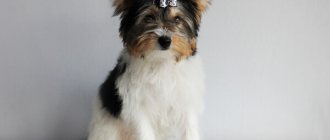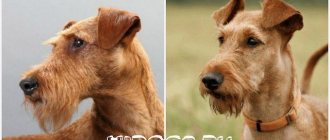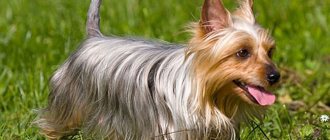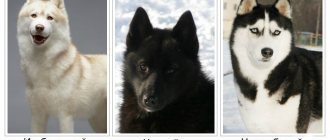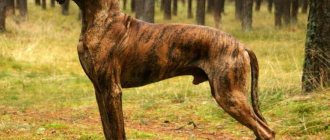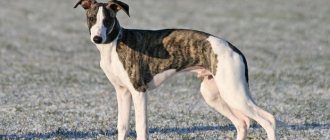History of the origin of the breed, interesting facts
The first evidence of terriers is found in materials dating back to 55 AD, when Britain became part of the Roman Empire. In those places, the Romans constantly encountered agile small dogs that hunted small game and rodents. They were called “earthen”, i.e. hunting on the ground. The terriers sneaked silently, getting prey even from hard-to-reach holes. Soon, brave dogs began to be taken for hunting larger animals - badgers, bears. Surprisingly, the terriers were not afraid of the size of the enemy: they were ready to grab the throat of any wild animal.
But this aggression did not extend to the household - the “earth dogs” got along well with children. Farmers especially loved them: terriers cleared areas of rodents, fought with martens, weasels, and skunks.
There is still debate about the origin of the breed. Most likely, the Dandie Dinmont was obtained by mixing the blood of Skye Terriers and Bedlington Terriers. It was from the latter that the dandy inherited his cute “hat”.
Interesting. Once upon a time, the Duke of Northumberland offered his manager a huge sum for an “earth dog.” For one dog, the rich man was ready to give the employee a whole farm. But the manager refused, saying that without his faithful dog he would not be able to handle such a gift.
History of the breed
The Dandie Dinmont breed has been reliably known since the 16th century. The ancestors of terriers were ancient Scottish relatives. At first, the breed was bred by gypsies and farmers in Scotland. They needed hunting dogs to kill rodents, especially rats.
Earth dogs, as they were called, did not allow predatory animals into the territory that ravaged people's farms and coped with attacks from skunks and martens. The agile dogs successfully cleared the area of pests.
Later, experienced breeders took up breeding. The improvement of terriers was manifested in the ability to hunt, thanks to their small size, badgers, otters, and other inhabitants of deep holes. Scottish breeders completed work on the breed in the 18th century.
Dandie Dinmont mustard color
Hunting dogs were distinguished by their lightning-fast reaction, excellent sense of smell, courage, and speed. When hunting, they weren’t even afraid of bears. The attractive appearance and obedient nature of the dogs attracted the attention of important people. Dogs began to be taken into care in rich houses.
The breed gained great popularity after the publication of Walter Scott's novel Guy Mannering. The main character Dandy Dinmont owns the “immortal six” terriers, of which he is immensely proud. The breed was named in his honor. Modern dogs have become more decorative, although they have not forgotten how to clear the territory of rodents.
Excerpt from the official breed standard and photographs
The breed was officially recognized in 1955. The representatives owe their name to the hero of one of W. Scott’s novels. Publication date of the English standard DANDIE DINMONT TERRIER: 10/3/2017.
Breed status:
- recognized on a specific basis;
- country of origin UK;
- is not subject to mandatory performance testing according to the FCI breed nomenclature.
Breed description, standard:
- height within 20-28 cm;
- weight within 8-11 kg;
- two color options: pepper, mustard;
- head: large, strong, corresponding to the overall size, with developed jaw muscles;
- the skull is wide, tapering towards the eyes;
- forehead is convex;
- the head is abundantly covered with silky, rather soft hair;
- nose black;
- scissor bite;
- the eyes are dark hazel, set wide and at the same time low, large and not protruding, the whites are not visible;
- the ears are hanging, wide, shifted to the back of the head, falling down the cheekbones;
- the neck is well developed, muscular, strong;
- the body is flexible, long;
- tail up to 25 cm, thick, without kinks, not collapsed, scimitar-shaped, tapering towards the tip;
- the forelimbs are muscular, short, always straight, widely spaced, paws slightly turned outward;
- the hind limbs are well developed, slightly longer than the forelimbs, widely spaced;
- Preferred claw color is black;
- double coat, with a very soft undercoat and a hard base (top coat);
- adult males must have 2 descended testes.
Character traits, advantages, disadvantages
Dandies can be both hunters and just pets. They are suitable for both single people and families with children. Dogs successfully perform guard duty and, despite their diminutive size, are always ready to protect their owner.
Despite their small size, Dandie Dinmont Terriers are very confident dogs.
Great for small apartments, but require long walks with active games.
Dinmonts are very active and love to hunt, so you need to constantly look after them on walks. They are loyal to animals that share housing with them, but do not favor those who meet them on the street.
The dandy especially loves children and is always ready for active, noisy games. Almost all breeders of the breed note: these representatives of terriers are cheerful, curious, devoted, very active, sociable and brave.
Despite their undeniable advantages, they also have some disadvantages. Dandies are stubborn and capable of making independent decisions. It is this feature that can become a stumbling block in establishing contact with the dog. Although this remark applies more to adolescents and adults.
It is very undesirable to have same-sex representatives of this breed: both will try to occupy a higher hierarchical level. In this case, constant conflicts cannot be avoided.
Important. Dinmonts are very jealous: they agree to accept only those animals with which they grew up. An adult terrier is unlikely to agree to “be friends” with an animal that appeared in the house after him. Although there is always room for exceptions.
Dandie Dinmont Terriers communicate well only with those animals with which they grew up.
In general, these are dogs that are easy to train, provided that the training is regular. The approach to the breed should be firm, but without pressure and rudeness. The ideal option is a playful form of training, with treats, toys, verbal and contact rewards.
The use of brute force is excluded: the dog will simply stop obeying. If the owner establishes contact with his pet, the terrier will give his life for him.
Care and maintenance of an adult dog
For dogs of this breed, constant contact with humans is very important. They can be kept in an apartment or private house. Dandy Dinmonts will not take up much space, but they need to be accustomed to their own bed as early as possible. Otherwise, the dog will choose the owners' bed to sleep.
In summer, terriers need air conditioning or a fan, in winter - warm overalls for walks in cold weather.
The right diet
Grandfather dinmonts are omnivores. The first thing they are given as natural food is boiled meat. It is better to choose lean varieties of meat - beef, chicken and turkey. Twice a week, meat can be replaced with sea fish, also with a low fat content. The diet can be varied with cereals, vegetables, fruits, cottage cheese and kefir.
The list of prohibited products includes:
- sausages and smoked meats;
- chips and crackers;
- chocolate and candies;
- flour products;
- raw unprocessed meat and fish;
- cream and sour cream.
With a natural diet, the terrier needs vitamins and special supplements to maintain good physical condition. Food portions should be small. If your pet leaves food in the bowl, the amount should be reduced.
Before purchasing dry food, it is better to consult a veterinarian and choose the best option for your pet.
Walking and physical activity
You need to walk your pet at least 2 times a day. Walking will help keep your body muscles toned. These dogs, especially at a young age, should not go up and down stairs, it is harmful to the back.
Active games are very useful during a walk. Dandie Dinmonts are capable of long hikes and tolerate travel well.
Training and education
Although loyal to their owners, when it comes to training, Dandie Dinmont Terriers tend to be skittish. They need to be shown as early as possible who is boss in the house.
Dogs are easy to train, but the commands they learn will have to be repeated more than once. When training, persistence is important, but without being rude or raising your voice at your pet. A dissatisfied look and a change in tone are enough.
Care and hygiene
Caring for terriers involves regularly performing some simple procedures.
- The wool is combed out with a stiff brush daily or every other day.
- The dog is trimmed once every six months. This is necessary to maintain a beautiful hair shape. The mustache and beard are simply trimmed.
- Doesn't need frequent bathing. For water procedures, special detergents are used.
- Ears are examined daily and cleaned twice a week.
- The claws are trimmed as they grow and trimmed with a special file.
- If there is excessive lacrimation, the eyes are treated with special means, if necessary.
- Brush your teeth with a brush and toothpaste 2-3 times a week.
Maintenance, grooming, cutting
The terrier is a wire-haired breed. He sheds differently than most dogs. For regular combing, use soft brushes.
It does not require dandy and full trimming: the coat is only periodically corrected in the necessary, “stray” areas. It is better to pluck individual hairs that stand out from the general “hairstyle” (guard coat) by hand.
Special trimming knives are used to remove the hair located between the toes and the underside of the paw. The hair to be removed is on the stomach, at the anus, on the tail (given a conical shape), in the inner corners of the eyes, the ears and the back of the nose are treated.
The coat of Dandie Dinmont Terriers requires periodic trimming.
Attention! It is better to entrust the haircut of a dog that is being prepared for an exhibition to a professional.
Feeding the Dandie Dinmont Terrier
A dinmont should eat a healthy, balanced diet. Typically, breeders recommend dry specialized food. It's really convenient, but choosing a quality product is not so easy. Here you need to take into account age, height, activity, and the presence or absence of diseases. The best option is holistic or super-premium food. They are of higher quality and contain a high percentage of natural meat. But the prices for good products are many times higher. If this factor does not bother you, we advise you to consider reputable brands.
Super premium:
- American Nutra Gold and Artemis;
- German Belcando and Bosch;
- English Arden Grange;
- Italian Almo.
Holistic class:
- Canadian Pronature Holistic, Orijen, Canidae and Acana;
- American Wellness, Chicken Soup, Innova.
If it is not possible to purchase any of the listed foods, you can stick to natural food. A dog's diet must include meat, cottage cheese, and vitamin and mineral supplements.
Important! When eating natural foods, smoked foods, baked goods, sweets, fatty meats, legumes, marinades and spices, and tubular bones should be excluded. When using ready-made food, the dog should always have access to water!
Super-premium or holistic food is suitable for feeding the Dandie Dinmont Terrier.
Dogs are modest in size and eat little. With natural nutrition, the portion is selected based on the needs of the dog itself. After eating, the dog's bowl should be clean. If the terrier does not finish, throw away the leftovers, and at the next feeding, reduce the portion slightly. If the dog does not leave the already empty bowl for a long time, it means that he has not finished eating. Don't add food to him, don't teach him to beg. Just increase the portion a little next time.
Monitor the condition of the terrier. Among this breed there are often food lovers. Overfeeding can cause unpleasant consequences: obesity, heart problems, gastric volvulus.
Health of the Dandie Dinmont Terrier, typical breed diseases
The health of these dogs is different from nature. The breed has excellent immunity. They rarely get sick. Of the infrequently encountered diseases, back problems, glaucoma and epilepsy rank first.
Excellent immunity does not give the owner the right to refuse vaccinations and regular preventive examinations by a veterinarian. As they age, some long-bodied dogs develop a sagging spine. This happens due to the gradual displacement of the interdisc vertebrae.
Dandie Dinmont Terriers have fairly good health and rarely get sick.
If your pet begins to behave strangely, limping or whining, stop active games and very long walks. In this case, consultation with a veterinarian and breeders is simply necessary. Experts will tell you how to reduce your dog’s discomfort.
Character
Although the Terrier was originally bred to be a determined hunter, it also has a long history of being bred primarily as a companion and show dog. As a result, they exhibit characteristics of both hunting dogs and companion dogs.
The Dandie Dinmont Terrier is known for its loyalty and affection towards its owner. However, like many other terriers, they are dogs of one or two people and do not particularly care for the company of strangers. Although these terriers do not usually display the overt aggression towards strangers that is common in some terrier breeds, they are rarely friendly and are usually nervous. Like most other terriers, they have a well-deserved reputation for being agile and quick to bite.
This is especially important when they feel threatened.
Although they may be socialized to the point that they accept children, they do not have a good reputation around children, especially small ones. Terriers generally do not appreciate rough treatment or even clumsy movements of children. They will regularly respond by growling, snapping, and sometimes biting. Additionally, these dogs have been bred to stand their ground fiercely in the face of small animals and tend to repeat this with small children.
If you need a dog for an elderly family, the Dandie Dinmont Terrier may be an excellent choice. If small children will frequent your home, this may not be the best breed for you.
The Dandie Dinmont Terrier is not the best breed for socializing with other dogs. Although this breed does not display nearly as much aggression as most other terriers, they tend to be very dominant and almost always stand their ground. They will do this to almost any dog, no matter how big it is.
While proper socialization and training help, they cannot eliminate the fundamental instincts of this breed. If you are looking to bring a dog into a home with existing dogs, you may encounter difficulties. It's definitely not advisable to keep two dogs of the same sex if you have a Dandie Dinmont Terrier, and keeping two male dogs is almost asking for trouble.
Dandie Dinmont Terriers are not recommended to be kept around small pets. These dogs have a strong chase instinct and will attack and kill hamsters, gerbils, ferrets and rabbits.
Proper socialization and training will eventually get most cats accepted. Just remember that a terrier that won't bother a cat he's known his whole life may endlessly bother a new cat you bring into your home.
At the same time, this is an intelligent and well-trained dog. They are known for being one of the most intelligent terrier breeds and can compete in agility and obedience. However, this breed is also known for its independence and sensitivity. These dogs will learn, and learn well, but owners must be careful in how they train them.
Training methods should be heavily reward based, as harsh methods such as yelling are likely to result in a backlash. Additionally, dominance should always be established over this breed, as they will strive to take control of everything.
The Dandie Dinmont Terrier is generally very relaxed when indoors and also does not require much exercise outside. Regular walks and frequent opportunities to play will satisfy most terriers.
However, this does not mean that the dog cannot exercise at all. With insufficient exercise, this breed tends to become nervous and irritable.
The Dandie Dinmont Terrier tends to suffer from small dog syndrome. This occurs when owners do not discipline a small dog like a large dog because they either appear less dangerous. This can cause small dogs to act as if they own the world and are the master of everyone and everything in it.
Dogs suffering from small dog syndrome tend to be aggressive, dominant, out of control, and rarely respect personal boundaries. Special training will prevent the development of small dog syndrome.
Terriers are often very excitable and usually express this excitement vocally. Although these dogs do not produce the long barking dog howl, their yelps can be quite high-pitched and loud. If not trained properly, many can cause noise complaints.
How to choose a Dandie Dinmont Terrier puppy: nuances you need to know
Try not to take dogs without documents. The lack of documented proof of purebred is a reason to doubt that they are offering you exactly the breed you want to purchase.
The dandy is not popular in Russia, but kennels officially registered in international canine systems do exist. To find out the coordinates of their owners, it is better to contact the management of the canine department in your city. The cost of a puppy varies from 600 to 2000 dollars and depends on the merits of the baby’s parents.
On a note. When choosing a dog, give preference to the smallest individuals in the litter. In relation to this breed, follow the rule: the smaller the better.
If in the future you are counting on an exhibition career, take into account one more nuance: those representatives who have a complex color are more valued, i.e. several shades, but one color.
Be sure to consider the dog's behavior. A puppy who immediately makes contact will be easier to work with in the future. It is better to avoid timid or noisy babies. You should not take a puppy with dull, loose fur.
Be sure to check if any of the parents (up to the 4th generation) have the characteristic diseases and problems listed above. The puppy must be healthy, well-built, and have an appropriate weight for its age. Fatness is welcome, but at the same time a bloated belly.
One of the important distinguishing features of the breed is the change in color as it grows. Newly born puppies are darker in color. They lighten gradually. Coat color is established by 8 months. Complete consolidation of the palette occurs only by the age of three.
Training and education
Thanks to its developed intelligence and loyalty to its owner, the Dinmont Terrier quickly learns all commands. Raising and training dogs goes quickly. The pet learns even complex commands on the fly. But it is better to train him in a playful manner, so the training will be more interesting for both the owner and his four-legged friend.
Note! You cannot put pressure or use physical force on dogs; only trust and affection will make them obey and respect their owner.
Reviews from owners and breeders
Valeria. Our dandy and those we met are very active and cheerful. I can’t say that they are aggressive towards strangers. Just the opposite! We often walk our dog in the yard - he is ready to lick every child if allowed. True, he doesn’t like barn cats. The barking starts if one of the strangers knocks or rings the doorbell. It is very easy to train and follows commands with pleasure. I recommend it to families with children!
Watch a video about an unusual and friendly breed of dog - the Dandie Dinmont Terrier.
Elena. This is my first terrier. Now he is almost eleven years old. My parents gave me a puppy for my fifteenth birthday. A faithful and reliable friend. I always take it with me – on hikes and trips. It tolerates the road perfectly, adapts to all conditions, the main thing is that the owner is nearby. And recently he saved me from a yard dog who was several times larger than my Kerry. I really love this breed!
Ilya. My wife dreamed about this dog for several years and saw it at an exhibition. Now she was interested in only one breed of dog: the Dandie Dinmont Terrier. I didn’t agree for a long time - I was worried that this little guy would cause a lot of problems. We got a puppy when our daughter was three years old. Now I can already say: I’m glad that my wife insisted on this particular breed. Our dimont does not leave the child's side either in the house or on a walk. Simply amazing mutual contact! A dog with a healthy psyche, an excellent immune system, and not allergic. No hair on the floor or furniture. We feed him natural food with the addition of a special complex that the veterinarian recommended to us. The dog is a total positive.

